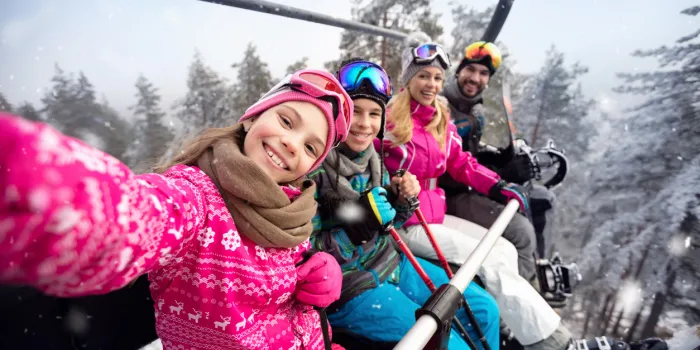If you love the idea of winter sports—think skiing, sledding/tubing, ice skating—but wonder if your bleeding disorder means you’re consigned to the indoors for the season, hold on: Your enjoyment of the winter wonderland doesn’t have to be limited to watching from the window.
Physical therapists Angela Forsyth, PT, DPT, and Alice Anderson, PT, DPT, PCS, co-authors of the National Hemophilia Foundation’s (NHF’s) Playing It Safe: Bleeding Disorders, Sports and Exercise guide, say that the best advice is to check with your treatment team before you engage in any winter sports. Don’t automatically assume a sport isn’t for you, notes Forsyth: “Your treatment team can help you come up with a strategy before you try a sport and find commonsense ways to make it safer, such as wearing the proper equipment.”
No matter what outdoor winter activity you engage in, some general safety advice applies. Be sure those who are with you (or staff at a facility) know what to do in case of an accident or injury. If there’s any risk of collision, wear a helmet. Also, check the weather report, and dress appropriately for the elements.
Get Outside–Safely
Before you grab your sled, skis or skates, make sure you’re prepared.
Sledding/Tubing/Tobogganing
These can be gentle family fun—or turn into high-velocity downhill activities, with the potential for collision and injury.
• Ask your treatment team if you should adjust your prophylaxis or infusion regime before jumping in.
• Choose a commercial course rather than a local hill. Why? “You’re probably safer on an organized slope where there are safety provisions in place, over the free-for-all that a hill near your home might be,” says Forsyth. Emergency personnel can more quickly be summoned on a commercial course.
• Avoid the activity if the terrain is particularly icy or has too many obstacles, like trees or excessive crowds.
Skiing
Skiing carries the risk of collision and falls, and it can be tough on joints, so approach it smartly.
• Get in fighting shape first. Ask a physical therapist to work with you on strengthening the muscles that support your knees and ankles.
• Keep in mind your history of joint issues. People who have already had knee bleeds, which make the joint weaker, are at more risk of another, says Anderson.
• Assess your balance and proprioception, which is the sense we have of where our limbs and joints are without having to look. People with bleeding disorders may have trouble with that, leaving them more vulnerable to injury.
Ice skating
Lacing up and gliding along can be great fun; just take proper precautions first.
• Make sure your skates fit properly. Skating can be tough on the ankles, so the first step is well-fitting skates that won’t put pressure on your joints.
• See a physical therapist first. A PT can work with you on strengthening as well as range-of-motion exercises for the ankle joint.
• Go skating at less crowded times to reduce the risk of colliding with other skaters.

